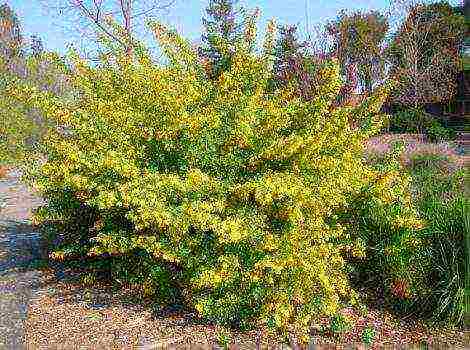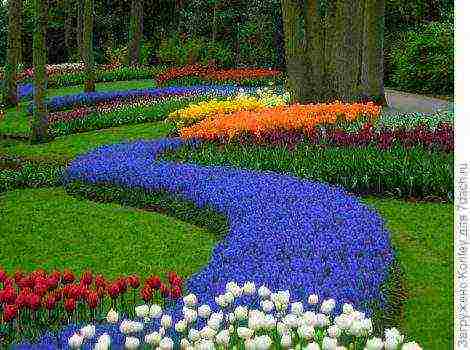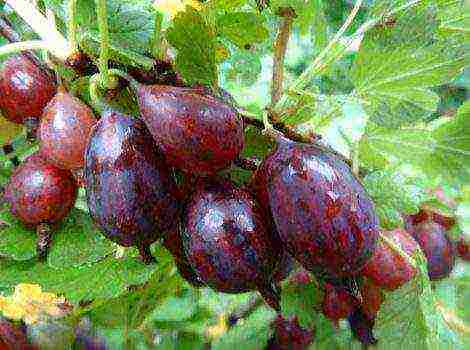Content
- 1 The largest varieties of sea buckthorn, description
- 2 The best varieties of thornless sea buckthorn
- 3 The most productive varieties
- 4 The most frost-resistant varieties
- 5 Sweet varieties of sea buckthorn
- 6 Low-growing varieties of sea buckthorn
- 7 Sea buckthorn varieties without thorns and thorns
- 8 Large-fruited sea buckthorn varieties
- 9 Sea buckthorn varieties for the Moscow region
- 10 Sea buckthorn varieties for the Urals and Siberia
More recently, many believed that sea buckthorn is wild berry, mostly growing on the territory of Siberia... But modern scientists have bred a huge number of varieties that are distinguished by increased taste, large size and other positive characteristics, growing both in the Urals and in the Moscow region.
The largest fruits are produced by the Essel variety. Lack of thorns speaks about the safety of working with a plant, such qualities can boast of the varieties Velikan, Solnechnaya and many others. The most productive the Botanical variety is considered, it is very often used on an industrial scale. Increased winter hardiness the variety Trofimovskaya, Golden Cob and Dar Katun are distinguished. In this article, we will take a closer look at the description of these varieties.
The largest varieties of sea buckthorn, description
Sea buckthorn, growing in the wild, bears fruits weighing 0.2-0.3 grams, the weight of berries of cultivated plants is 0.5 grams. But there are varieties that are capable of producing fruits, the mass of which reaches 1.5 grams.
Openwork
 Sea buckthorn grade Openwork
Sea buckthorn grade Openwork
This tree has a beautiful, spreading crown, there are no thorns on the branches. The fruits are bright orange in color, resembling a cylinder in their shape. The weight of one berry reaches 1 gram. Sea buckthorn of this variety ripens early and gives a bountiful harvest.... It is resistant to frost, drought and many fungal diseases.
Augustine
 Sea buckthorn grade Augustine
Sea buckthorn grade Augustine
Fruits of this variety weigh about 1.1 grams and are orange in color and ovoid. The fruits are collected in loose clusters, which greatly simplifies the process of their collection.... A small number of thorns are present on the shoots. Sea buckthorn ripens early, 16-18 kg of harvest is harvested from one adult tree.
Elizabeth
 Winter-hardy sea buckthorn variety Elizaveta
Winter-hardy sea buckthorn variety Elizaveta
A shrub with a neat, compact crown that does not require lengthy pruning. On average, the berries weigh 0.9 grams, have a sweet and sour taste with light hints of pineapple. Fruits grow on long stalks, easily detachable from the brush, ripen at a later date... Among other things, the variety is distinguished by high winter hardiness and resistance to pest attacks.
Essel
 Sea buckthorn grade Essel
Sea buckthorn grade Essel
The variety is a novelty of Siberian breeding. Berries have excellent characteristics, their weight reaches 1.2 grams, oval shape, sweet taste, dessert. Fruits ripen in August, are characterized by weak attachment to the brush.
The best varieties of thornless sea buckthorn
Sea buckthorn without thorns is one of the most important discoveries of breeders. These plants are safe for the grower and are much easier to care for and harvest.
Giant
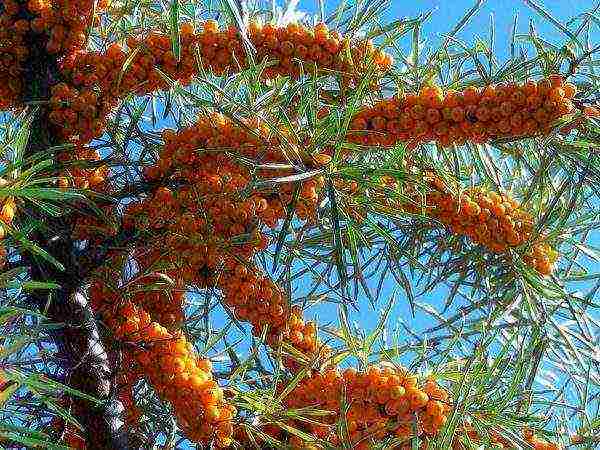 Thornless sea buckthorn variety Giant
Thornless sea buckthorn variety Giant
The variety can be sold as a shrub or as a tree. Has a conical crown without thorns, reaches a height of 3.5 meters... The fruits are bright orange in color, cylindrical in shape, grow on a short stalk, have a sweet and sour taste and are large in size.
Solar
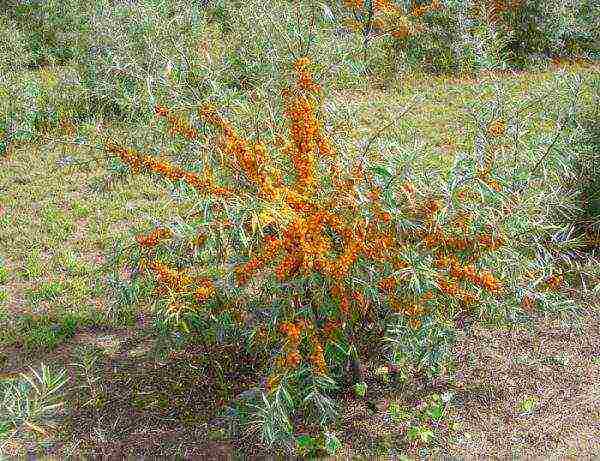 Sea buckthorn bush grade Sunny
Sea buckthorn bush grade Sunny
A large shrub with a spreading crown, the safety of the variety is ensured by the absence of thorns. Amber-colored fruits reach 0.7 grams by weight, have a pleasant sweet taste and increased oiliness.
Altai
 Altai sea buckthorn variety
Altai sea buckthorn variety
There are practically no thorns on the neat crown. The fruits ripen at the end of August, weighing an average of 0.7 grams. Have a pleasant sweet taste with a light pineapple scent... Berries are distinguished by light, dry separation from the stalk.
Friend
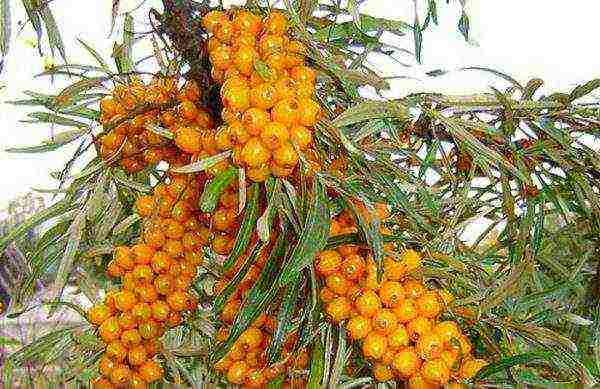 Sea buckthorn grade Girlfriend
Sea buckthorn grade Girlfriend
A medium-sized shrub with a slightly spreading crown. The shoots of the plant are straight and thin, there are no thorns on them. Leaves are shiny, light green with light pubescence. The fruits are large in size, their weight can reach 1 gram, the shape is oval, the color is rich orange... The berries taste sweet and sour, they can be used both for fresh consumption and for various types of processing.
The most productive varieties
Recently bred sea buckthorn varieties are endowed with the highest yield. From one bush, you can collect up to 18 kilograms of fruit, instead of the previous 5-6 kilograms.
Botanical
 Sea buckthorn grade Botanicheskaya
Sea buckthorn grade Botanicheskaya
The variety is often used commercially, with proper care, up to 20 kilograms of harvest can be harvested from one 5-year-old tree... The fruits are large in size, red-orange in color and have a pleasant, juicy taste. The berries are easily separated from the stalk and tolerate transportation well.
Moscow beauty
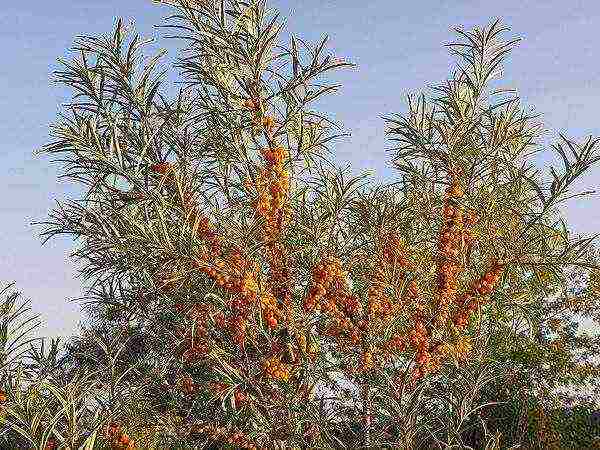 Sea buckthorn Moscow beauty
Sea buckthorn Moscow beauty
A medium-sized shrub with a compact crown. The rich, orange berries have a dessert flavor and are quite large in size (0.6 grams). The variety brings a bountiful annual harvest, up to 15 kilograms of fruit are harvested from one plant.... In addition, the Moscow beauty is distinguished by good winter hardiness and unpretentiousness in care and growing conditions. It is immune to most diseases.
Chuiskaya
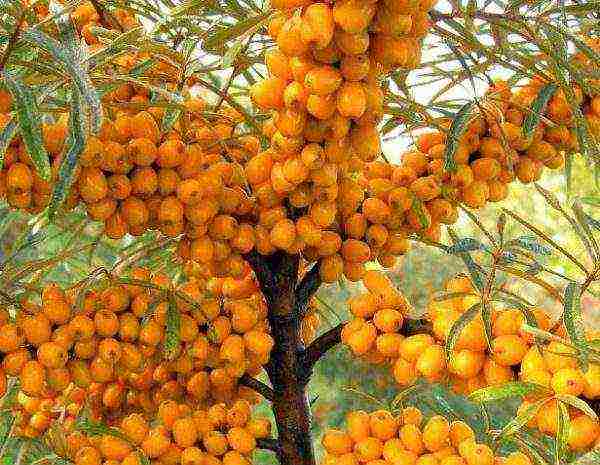 Chuiskaya sea buckthorn variety
Chuiskaya sea buckthorn variety
A compact tree with a spreading, sparse crown, lends itself well to shaping. 10-12 kilograms of oval, slightly elongated berries are harvested from one plant... The fruits ripen in summer and have a pleasant sweet and sour taste.
Darling
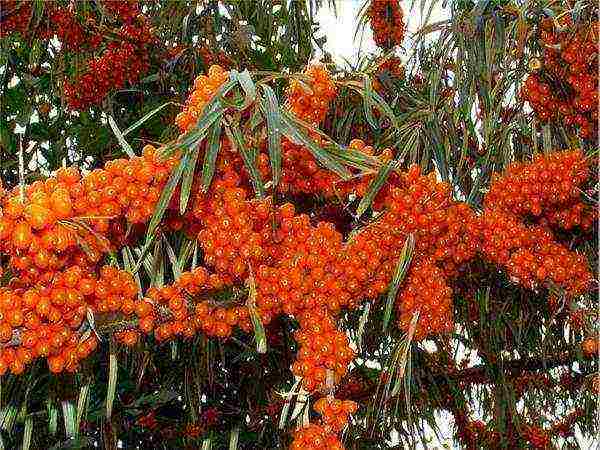 High-yielding sea buckthorn grade Favorite
High-yielding sea buckthorn grade Favorite
A medium-sized shrub with a flat-oval crown. Shoots are straight, practically without thorns, whitish bloom is characteristic. The top of the leaf is light green and the bottom is silvery. The fruits are orange in color and oval. The skin is sweaty, the pulp is slightly loose, very pleasant to the taste. The variety ripens at the end of August and brings a stable and large yield, which is suitable for various types of conservation.... The variety is characterized by increased winter hardiness and immunity to most diseases.
Nivelena
 Nivelen sea buckthorn variety
Nivelen sea buckthorn variety
A medium-sized shrub with a slightly spreading umbrella-shaped crown. Shoots are light brown, matte, thorns are present in small quantities. The leaves are small and green. Berries of large size, yellow-orange, spherical shape... The pulp has a good aroma and sweet and sour taste. Such berries ripen at the end of summer, tolerate transportation well and can be stored for a long time. Also, the variety is characterized by increased winter hardiness and disease resistance.
The most frost-resistant varieties
Sea buckthorn belongs to Siberian plants, therefore good frost resistance is its natural characteristic. But there are varieties for which this indicator is at the highest level.
Ear of gold
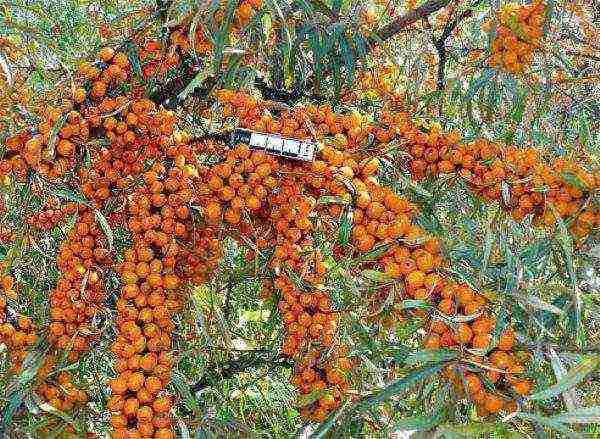 Frost-resistant sea buckthorn grade Golden ear
Frost-resistant sea buckthorn grade Golden ear
A sea buckthorn variety that begins to bear fruit as early as the 3rd year of life. You can also distinguish a small number of thorns. Berries of golden-orange color weighing up to 0.5 grams are collected in dense cobs... The main advantage is increased winter hardiness.
Trofimovskaya
 Sea buckthorn grade Trofimovskaya
Sea buckthorn grade Trofimovskaya
Tall shrub with a spreading, umbellate shape. Bears large fruits weighing up to 0.7 grams of orange color with red tints... The shape of the berries is elongated. The variety is distinguished by a high content of ascorbic acid. Trofimovskaya is able to survive not only the winter cold, but also the spring frost, which are more destructive for most crops.
Botanical amateur
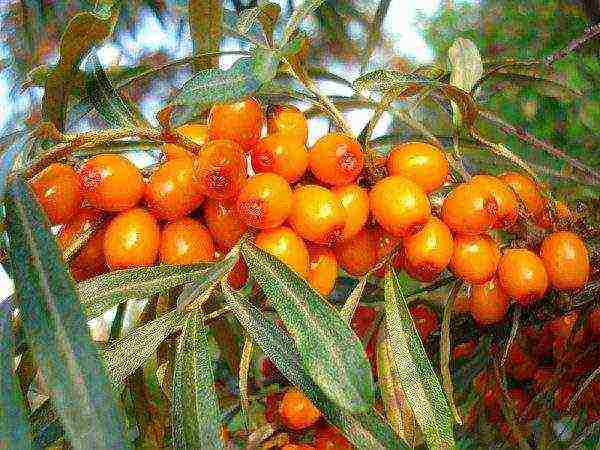 Sea Buckthorn Botanical Amateur
Sea Buckthorn Botanical Amateur
The shrub grows up to 4 meters in height, the crown has a pyramidal shape. The leaves are large, light green in color, the thorns are practically absent. The berries ripen at the beginning of August, and if the harvest is not harvested on time, it will overripe and become not transportable. Fruits are large, yellow-orange with scales. The shape is oval-cylindrical. The pulp has a pleasant taste and pineapple aroma. Same the variety is very productive, 15 kilograms of harvest are harvested from one bush, sea buckthorn begins to bear fruit already at 3-4 years of age... Botanical amateur is resistant to frost, drought and various diseases.
Gift of Katun
 Frost-resistant sea buckthorn variety Dar Katuni
Frost-resistant sea buckthorn variety Dar Katuni
The bush grows up to 2.7 meters in height, the crown is oval, the thickening is average. There may be a small number of thorns, or they may be completely absent. The leaves are concave, deep green. The fruits are orange in color and round in shape, their average weight is 0.7 grams... The crop can be harvested in the second half of August. Fruiting of sea buckthorn begins at 3 years of age and continues until 12 years of age. 14-16 kilograms of harvest are harvested from one shrub. The variety is resistant to frost and disease.
Sea buckthorn contains a large amount of vitamins and minerals, therefore, such berries have a beneficial effect on the human body. Due to the high content of oils, this culture is often used in cosmetology.
1. Sweet varieties of sea buckthorn
2. Low-growing varieties of sea buckthorn
3. Varieties of sea buckthorn without thorns and thorns
4. Varieties of large-fruited sea buckthorn
5. Varieties of sea buckthorn for the Moscow region
6. Sea buckthorn varieties for the Urals and Siberia
Sea buckthorn is popularly called the golden tree for its beautiful appearance at the time of fruit ripening and the wonderful healing properties of its sunny berries. To date, a wide variety of sea buckthorn varieties have been bred for every taste. When buying seedlings, it is better to choose sea buckthorn forms, zoned for planting in your region.
Since sea buckthorn is a dioecious crop, both female and male plants should be planted to obtain stable yields. Moreover, for pollination of 4-6 female bushes, one male specimen is enough. Pollen from male staminate flowers is transferred to female pistillate flowers exclusively by the wind. The closer the pollinator is to the female sea buckthorn bushes, the better the pollination and higher yields.
Sex differences in sea buckthorn appear in the third or fourth year of growth during the laying of flower (generative) buds. Sea buckthorn - "boy" is distinguished by large buds like a cone with 7-8 covering scales, while the "girl" has small buds with two scales, resembling the back of a bug.
It is better to purchase sea buckthorn seedlings grown from cuttings. Such plants inherit the sex and variety of the mother tree. When you buy in nurseries, you get seedlings of the type and sex you need. You can also harvest cuttings from varietal plants yourself and grow seedlings. Propagation by seeds and shoots usually does not bring the desired results.
Spring is the best time to plant sea buckthorn. You need to choose a sunny, spacious place with light neutral soil without stagnant moisture.Subject to the rules of agricultural technology and a good choice of sea buckthorn varieties, you will provide yourself with a tasty and healing berry for a long time.
Sweet varieties of sea buckthorn
"Darling"
The fruits of the sea buckthorn "Lyubimaya" are intense orange, large, with a strong skin. The pulp has a pronounced sweetness (the proportion of sugars is 7.3%). Bushes of moderate height with straight, ringed branches. High winter hardiness, slightly affected by diseases and pests. The fruits ripen by the end of August. The yields are plentiful and annual. The long stem and dry separation of the berries make harvesting much easier. "Favorite" is good fresh and for making juice, does not lose its taste when frozen.
• Fruit weight 0.7 gr.
• Harvest 8 kg per bush
• Mid-season
Dignity: sweet taste of fruits, dry separation of berries, good transportability
Flaws: the presence of thorns on the shoots
Altayskaya
Altayskaya is remarkable for its fruits with a high sugar content (9.7%). The pulp is sweet, juicy. The plant is of medium height (3-4 m) with a dense but compact crown. The branches are almost without thorns. It tolerates severe frosts, it is resistant to diseases and pests. Fruits are oval, bright orange in color with a dry separation. Ripening time - early September, used fresh and for processing.
• Fruit weight 0.7 - 0.9 gr.
• Harvest 7 - 8 kg. from the bush
• Mid-season
Advantages: sweet berries with pineapple aroma, thornless shoots, dry fruit pulling
Flaws: medium yield, demanding watering
"Pearl"
Among the sweet dessert varieties is the "Pearl". The fruits of this species are bright orange in color on a long stalk (5-6 mm). The pulp is sweet with a delicate aroma (sugar content up to 8%). The sea buckthorn bush is low (up to 2.5 m), compact, branches with sparse thorns. A variety with excellent frost resistance, it begins to bear fruit in the third year. In mid-August, a crop of 10-12 kg ripens per bush. Disease and pest resistance is good.
• Fruit weight 0.7 - 0.8 g.
• Harvest 10 - 12 kg. from the bush
• Ripening period - early
Advantages: fragrant sweet fruits, low perinence, excellent frost resistance, early maturity
Flaws: low drought resistance
"Elizabeth"
Dessert type with delicious sweet and sour fruits (sugar content 7-8.9%). A small bush with a crown of moderate density. "Elizaveta" perfectly tolerates frosts and is weakly susceptible to diseases. A young plant begins to bear fruit in the fourth year. Fruits are large, cylindrical, orange. 5-6 mm long stems and semi-dry separation facilitate harvesting. The variety has a good yield.
• Fruit weight 0.9 - 1.1 g.
• Harvest 14 -15 kg. from the bush
• Late ripening
Advantages: large sweet berries, low prickly branches, good yield.
Flaws: late ripening
Low-growing varieties of sea buckthorn
In low-growing varieties of sea buckthorn, the height of the bush does not exceed 2-2.5 m, which greatly facilitates harvesting and caring for the plant.
"Galerit"
Low bush up to 2 m, compact crown with short shoots. Fruits are conical, elongated, light orange with a reddish base, large (0.8 g). The pulp is juicy sweet and sour with bitterness. The variety is resistant to major diseases. Sea buckthorn ripens in mid-September. The harvest from a bush can be 10 kg.
• Fruit weight 0.8 g.
• Harvest 10 kg. from the bush
• Late ripening
Advantages: undersized, fruitful, dry take-off of berries, disease-resistant
Flaws: late fruit ripening, thorny branches
"Thumbelina"
A very accurate name for this type of sea buckthorn. The bushes grow up to only 1.5 m, the crown is compact, shoots with a small number of thorns. Fruits are dark orange, medium-sized, oblong in shape. The peel of the berries is thin, bursts when overripe. Variety "Thumbelina" is winter-hardy, slightly susceptible to diseases and pests. Sea buckthorn ripens until mid-August.Yields are abundant up to 20 kg per plant.
• Fruit weight 0.6 - 0.7 gr.
• Harvest 20 kg. from the bush
• Early ripening
Advantages: undersized, high-yielding, frost-resistant
Flaws: wet berry separation
Bayan-Gol
One of the best undersized varieties in many respects. Bushes 1-1.2 m high have a compact crown. The branches are straight, moderately leafy with small spines at the ends. Fruits are bright orange with a reddish top, medium in size with strong skin. Sweet and sour taste (sugar content 7%). The 5 mm long stem and dry separation of the berries make harvesting easier. Bayan-Gol begins to bear fruit for the third year already. By mid-August, the ripe crop is ready for harvest. A species with excellent winter hardiness and resistance to desiccation and gall mites.
• Fruit weight 0.6 gr.
• Harvest 5 kg. from the bush
• Early ripening
Advantages: undersized, early-growing, dry separation of berries, high winter hardiness
Flaws: average yield
"Ryzhik"
Weak form with a moderately spreading crown. Fruits are oval-elongated, dark red in color on a long stalk. Sweet and sour dessert taste. Berries are large (0.7-0.9 g) for universal use. The variety tolerates frost well, is resistant to diseases. Sea buckthorn ripens in the second half of August. The yields are plentiful. The Ryzhik variety has been zoned for cultivation in the Urals.
• Fruit weight 0.7 - 0.9 gr.
• Harvest 19 kg. from the bush
• Mid-season
Advantages: low-growing, productive, frost-resistant
Flaws: prickly shoots
Sea buckthorn varieties without thorns and thorns
The thorny shoots of sea buckthorn greatly complicate the picking of berries. But breeders are successfully solving this problem. Many varieties have been developed that practically do not have thorns and thorns. Let's take a look at some of them.
"Friend"
Plants of moderate growth, moderately spreading crown with straight shoots without thorns and thorns. Berries are large (0.8-1.0 gr.) Orange sit on the middle (3-4 mm) stalk with a dry separation. The pulp is sweet and sour aromatic (sugar content up to 6%). The species is characterized by strong frost resistance (up to -40) and good disease resistance. The harvest ripens by the end of August.
• Fruit weight 0.8 - 1.0 g.
• Harvest 6 - 7 kg. from the bush
• Mid-season
Advantages: shoots without thorns, low growing, dry separation of berries, strong frost resistance
Flaws: average yield
"Excellent"
"Excellent" is remarkable for the complete absence of thorns on the branches. Bushes of medium height with a spreading crown. Fruits of a cylindrical shape are light orange on a stalk 3-4 mm long with a semi-dry separation (when harvested, they are damaged, but not enough). Sweet and sour dessert taste. Winter hardiness and disease resistance are decent. At the end of August, the crop can be harvested. This species can be successfully grown everywhere.
• Fruit weight 0.7 - 0.9 gr.
• Harvest 12 -15 kg. from the bush
• Mid-season
Advantages: shoots without thorns, dessert taste of berries, fruitful, high resistance to fungal drying
Flaws: can be damaged by gall mites and sea buckthorn flies
"Giant"
"Giant" is a popular type of sea buckthorn due to the absence of thorns on the shoots. Treelike shrub 3-3.5 m high with a sparse crown and drooping branches. Fruits are cylindrical, yellow-orange in color, large (0.8-0.9 g). The taste of the pulp is sweet and sour with tart notes. The peduncle is 4-5 mm long with a semi-dry separation. Winter-hardy variety with good disease resistance. Sea buckthorn ripens by mid-September.
• Fruit weight 0.8 - 0.9 gr.
• Harvest 5-10 kg. from the bush
• Late ripening
Dignity: lack of thorns on branches, large fruits of universal use
Flaws: average yield, late ripening
"Chechek"
The "Chechek" form has bushes of moderate growth, there are practically no thorns on the branches. Drupes of a cylindrical shape, orange with a reddish tinge at the base, large 0.8-1.0 g. The pulp is sweet and sour (sugar up to 8%) with a high content of oil and carotenoids.Berries on a long stalk with a dry separation. The plant can withstand frost remarkably, has good disease resistance. The harvest ripens in the first half of September.
• Fruit weight 0.8 - 1.0 g.
• Harvest 10 -12 kg. from the bush
• Mid-season
Advantages: non-prickly shoots, low-growing, large-fruited, dry separation of berries
Flaws: protection against sea buckthorn flies is required.
Large-fruited sea buckthorn varieties
In nature, wild sea buckthorn has berries weighing 0.2-0.3 grams. In cultivated varieties of sea buckthorn, the fruit weight is usually 0.4-0.6 g. Large-fruited species differ in fruits weighing from 0.7 g to 1.5 g. Below is a description of the record-breaking varieties for large-fruited.
Essel
One of the advantages of the Essel variety is its large (up to 1.2 g) fruits. Bushes are low, spreading with thornless shoots. Drupes are bright orange cylindrical with pronounced sweetness in taste and light aroma. The stalk is long (5-6 mm), semi-dry separation of berries. It tolerates frost well. Ripening time - the end of August. Yields for a young plant are about 5 kg, under favorable conditions up to 10 kg.
• Fruit weight 0.9 - 1.2 g.
• Harvest 5-10 kg.
• Mid-season
Advantages: large-fruited, sweet berry taste, very low perforation
Flaws: semi-dry separation of berries, without protection suffers greatly from sea buckthorn fly
"Augustine"
Large-fruited excellent variety. Drupes are large, weighing 1.1-1.4 grams. Bushes of moderate growth with a neat crown. Twigs with few thorns. The fruits are round, bright orange with a thin skin. Long stem with a slight separation. The pulp is sweet and sour (the proportion of sugars is about 9%), tender. The berries are good both fresh and for harvesting. Good frost resistance. Sea buckthorn ripens in mid-August. Yields from a young bush are 5 kg, increasing to 17 kg in an adult plant.
• Fruit weight 1.1 - 1.4 g
• Harvest 17 kg.
• Early ripening
Advantages: large tasty berries, low permeability, high-yielding, early ripening
Flaws: average resistance to diseases and pests
"Sun"
The variety "Solnyshko" has large (0.9-1.6 grams) cylindrical drupes of red-orange color on a long stalk with a dry separation. The pulp is fragrant and sweet and sour taste. Shrub of small height, slightly spreading crown, there are almost no thorns on the shoots. Frost-resistant, disease resistance satisfactory. Sea buckthorn ripens at the end of August. Up to 11 kg can be removed from the bush.
• Fruit weight 0.9 - 1.6 g.
• Harvest 11 kg.
• Mid-season
Dignity: large sweet fruits, low thorny branches, dry separation of berries, high resistance to drying out
"Amber necklace"
The variety "Amber Necklace" has an average weight of berries of 1.5 g. Shrub of medium height, moderately spreading crown. Drupes are oval, amber-orange with a strong skin on a long stalk. The taste is sweet and sour with a predominance of sourness (sugars 5%, acid 2.4%). A variety with good frost resistance and resistance to diseases and pests. The harvest ripens by mid-September. From a bush, you can collect up to 14 kg.
• Fruit weight 1.5 g.
• Harvest 14 kg.
• Late maturing
Advantages: large fruits, high frost resistance and disease resistance, good yield
Flaws: late ripening
Sea buckthorn varieties for the Moscow region
Sea buckthorn varieties for the Moscow region and the middle zone are well adapted to the climate of these areas with temperature changes in winter and sometimes with dry summers. Below is a description of several species of sea buckthorn bred in the botanical garden of Moscow State University. Lomonosov and successfully grown in the Moscow region.
"Moscow beauty"
The bushes are medium-sized, the crown is moderately spreading with straight, slightly thorny branches. Drupes are round, bright orange with a reddish tinge at the base and at the crown. The taste of Moskovskaya Krasavitsa is sour with a slight sweetness (sugars 2.8%, acids 2%).This species perfectly tolerates frost and is resistant to many diseases. The harvest ripens in mid-August and is 7-12 kg per adult plant.
• Fruit weight 0.6 gr.
• Harvest 7 - 12 kg.
• Mid-season
Advantages: thornless shoots, dry separation of berries, fruitful, winter-hardy
Flaws: medium-sized berries with a sour taste
"Gift to the garden"
Shrub of medium height (about 3 m), compact. Shoots have thorns only at the tops. Berries are elongated-rounded, dense orange with a reddish base, average weight 0.6 - 0.8 g, the stalk is long (5-6 mm), thin. The pulp is tender, sourish in taste. "Gift to the Garden" begins to bear fruit already in its third year. A variety with excellent frost and disease resistance. It is slightly damaged by pests. The harvest is abundant, ripening in the second half of August.
• Fruit weight 0.6 - 0.8 g.
• Harvest 15 - 20 kg. from the bush
• Mid-season
Advantages: shoots with sparse thorns, fast-growing, frost-resistant, productive, dry separation of berries
"Moskvichka"
Shrub about 2.5 m tall with a neat crown. Drupes are bright orange in color, reddish at the base and at the crown. The pulp is fragrant with a sweet and sour taste. The fruits are large with a thin skin, the stalk is long. "Moskvichka" perfectly tolerates frosts, practically is not damaged by diseases and pests. The harvest ripens by the beginning of September.
• Fruit weight 0.8 g.
• Harvest 10 kg. from the bush
• Mid-season
Dignity: tasty large fruits, high winter hardiness, good transportability
Flaws: thorns on shoots
"Nivelena"
The plant is medium-sized, the crown is moderately spreading, on the branches there are single sparse thorns. Drupes are yellowish-orange round in shape with aromatic sweet and sour pulp, medium size 0.5 - 0.8 g. A variety with excellent winter hardiness, slightly damaged by diseases and pests. Sea buckthorn begins to bear fruit in the third year after planting. It ripens in the second half of August. Yields can reach 25 kg under favorable conditions.
• Fruit weight 0.5 - 0.8 g.
• Harvest 25 kg.
• Mid-season
Advantages: weak permeability, high winter hardiness, productive, fast-growing
Flaws: semi-dry separation of berries
Sea buckthorn varieties for the Urals and Siberia
"Openwork"
A shrub of low growth, spreading with branches without thorns. Fruits are orange, cylindrical on a long stalk, large (1.0 - 1.2). The pulp is sweet and sour (the proportion of sugars is up to 9%). The variety has excellent winter hardiness, drought resistance, disease resistance. The harvest ripens at the end of August. Productivity 6 kg.
• Fruit weight 1.0 - 1.2 g.
• Harvest 6 kg. from the bush
• Mid-season
Advantages: large fruits, shoots without thorns, high winter hardiness
Flaws: damaged by sea buckthorn fly, low yield
"Jam"
A low-growing bush (about 2.5 m) of moderate density with shoots without thorns. Fruits are red-orange, oval in shape on a long stalk with a semi-dry margin. The pulp has a sweet and sour dessert taste. "Jam" has a high content of carotenoids and oil. It tolerates frosty winters well, relatively susceptible to diseases and pests. Ripening time - the end of August. Yield 9 -12 kg per plant.
• Fruit weight 0.7 - 0.8 g.
• Harvest 9 - 12 kg per bush
• Mid-season
Advantages: short stature, thornless shoots, tasty large berries, high winter hardiness
Flaws: semi-dry separation of berries, relative resistance to sea buckthorn fly
Chuiskaya
A bush or tree of medium height with a thin crown, branches with a few thorns. Fruits are large, cylindrical, orange on a short stalk with a semi-dry margin. The taste of the pulp is sweet and sour. A variety with high winter hardiness. Ripening time is the second half of August. The harvest is 10-12 kg. from one bush. Disease and pest resistance is not good enough.Sea buckthorn "Chuiskaya" is also zoned for the Moscow region.
• Fruit weight 0.8 - 0.9 gr.
• Harvest 10 -12 kg. from the bush
• Mid-season
Advantages: weak roundness of shoots, large fruits of universal application, high frost resistance
Flaws: semi-dry separation of berries, average resistance to diseases and pests
" Lady fingers"
"Ladies fingers" is a variety of the Chelyabinsk selection. Bushes of medium height with a moderately spreading crown. Drupes are large, cylindrical, bright orange. The pulp is sweet and sour with a pleasant taste. The stalk is long, dry separation of berries. A variety with excellent winter hardiness. The ripening time of the crop is the end of August. Productivity 6 kg. from the bush.
• Fruit weight 1.0 - 1.3 g.
• Harvest 6 kg. from the bush
• Mid-season
Advantages: large fruits of dessert taste, dry separation of berries, high winter hardiness
Flaws: weak resistance to sea buckthorn fly
Well, a few words about pollinating varieties. Sea buckthorn varieties Alei, Dwarf, Dear friend, Ural are bred exclusively for pollination of female sea buckthorn plants. They are characterized by long flowering and large amounts of pollen - volatile and viable. It is enough to plant one such bush and a high yield will be ensured.
Save article to:
Dear visitors of the "Dacha Plot", tireless gardeners, gardeners and flower growers. We offer you to pass the aptitude test and find out whether you can trust the shovel and let you into the garden with it.
Test - "What kind of summer resident I am"
Share this article with your friends:
A sprawling shrub dotted with sharp thorns, with small sour yellow-orange berries - such were almost all varieties of sea buckthorn some 35-40 years ago. It was then that the sea buckthorn boom began, caused by the advertised healing properties of the Siberian berry. The modern assortment includes dozens of cultivars and hybrids, which are distinguished by large berries with a dessert taste and delicate aroma, high yield, decorative form of bushes and boles, a high level of adaptation to the soil and climatic conditions of Russia.
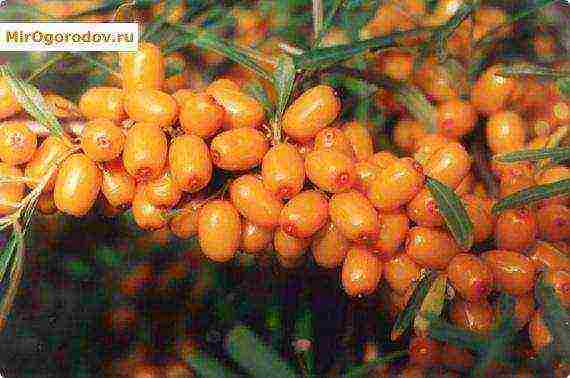
"Gold reserve" of Siberia
Siberian berry - pantry of sun and health
The most accessible source of natural vitamins is berries and fruits, but in terms of their quantitative and qualitative composition, none of the fruit and berry crops can be compared with sea buckthorn, and none has received such an eloquent synonym - the pantry of the sun. This nondescript Siberian berry contains the entire vitamin alphabet, it is the absolute leader in the amount of biologically active substances and microelements, healing oils and organic acids.
The plant belongs to the Lokhovye family, on the territory of Siberia, Central Asia, the European part of the continent, the sea buckthorn species Krushinovaya grows. This is a berry shrub, but it is often grown in one trunk, forming a tree, or grafted onto a bole. The standard height is 2.5–3 m, without pruning it can grow up to 6 m. The crown is branched, reaches 4–5 m in diameter, gives an active summer growth - from the buds located closer to the top of the branch, a whorl of young shoots is formed, ending in thorns ... One of the areas of breeding is the breeding of varieties of sea buckthorn without thorns, and experts have succeeded a lot in this.
One of the biological features of the plant is fruiting exclusively on the shoots of the second year of vegetation. After the return of the crop, the branch is bare, and vegetative and generative growth moves closer to its edge. If the plant is not regularly pruned, then gradually the entire crop will be on top.
The second important characteristic is the dioeciousness of the bush. Only female trees are capable of fruiting, but in order for them to be pollinated, at least one male sea buckthorn variety is planted on several specimens. Pollinating varieties bloom beautifully, they can be distinguished for 3-4 years by their larger scaly buds. The pollen is very fine, carried by the wind.
The third feature is the ability of the root system to assimilate atmospheric nitrogen, which allows the plant to successfully survive even on depleted soils. This is possible due to the superficial arrangement of the roots and the formation of numerous growths on them - nodules.
Sea buckthorn blooms in May, forming inflorescences in the form of short brushes. As the berries grow, they stick very tightly to the twig, resembling an ear of corn. They can be different in shape - round, ovoid, elongated, similar to a barrel, in color - in all shades of orange. Berries ripen depending on the variety - from August to October.

Multicolored abundance of healing products
Note! On sale there are combined sea buckthorn plants - this is when a female variety is grafted onto a male specimen. Such a shrub consists of branches with a feminine and masculine principle, bears fruit well, gives larger fruits.
Varieties: the most, the most ...
Two schools of sea buckthorn breeding are successfully operating in Russia - Siberian and European. More than 7 dozen new varieties have been developed - large-fruited, fruitful, with improved taste characteristics, increased vitamin content, less studded shoots. In order not to get lost in the abundance of the proposed varieties, we suggest considering them in the context of the characteristics most attractive to the gardener.
The largest
Sea buckthorn, ripe in the wild, weighs only 0.2-0.3 g, the standard weight of fruits of cultivated plants is 0.4-0.5 g, large-fruited varieties are capable of producing berries from 0.7 to 1.5 g. this indicator and several indisputable record holders.
- Openwork is a universal variety with bright orange, cylindrical berries weighing up to 1 g. In addition to large juicy fruits of a pleasant taste, there are other attractive characteristics - a sprawling dense crown, no thorns, early ripening, good yield, resistance to fungal infections, frost, heat, drought.
- Augustine's sea buckthorn is no less attractive in this regard - the mass of juicy orange ovoid fruits reaches 1.1 g, and a loose brush greatly facilitates their collection. The variety is characterized by a slight stitching of the shoots, early maturity, yield at the level of 15-16 kg per adult plant.
- The Elizaveta variety has a slightly smaller berry (0.8–0.9 g), has a sweet and sour taste and a delicate aroma with pineapple notes. They are located on a long stalk and come off well from the brush. In addition, gardeners love this shrub for its moderate growth, neat compact crown, winter hardiness, resistance to pests and pathogens. The only negative is late ripeness.
- sea buckthorn Essel is a novelty of Siberian selection. The berries are orange, oval in shape, not very tightly fastened in the brush, the average weight is 0.9–1.2 g. The sweet dessert taste allows us to classify the variety as not only large-fruited, but also one of the most delicious. Ripening period - August.
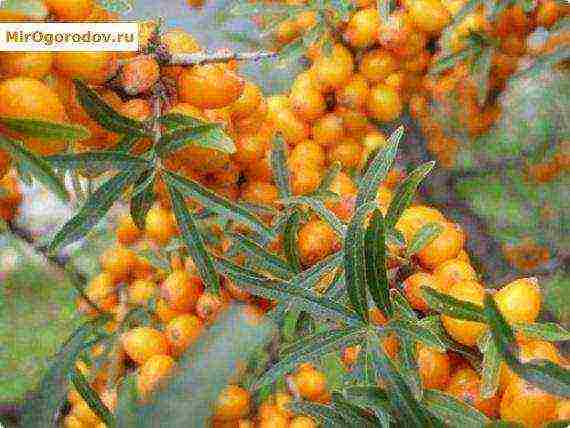
Weighty bunches of openwork sea buckthorn
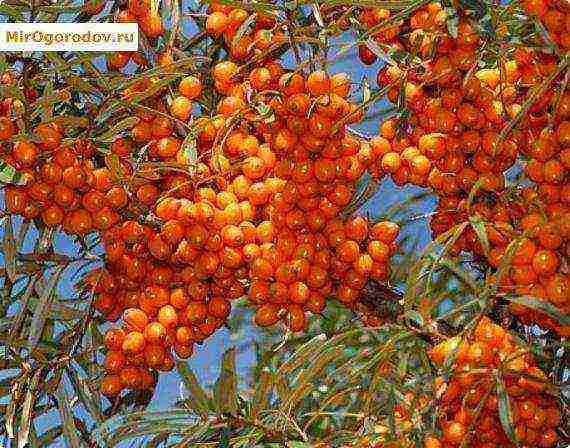
Harvest beauty Elizabeth
The most delicious
Those who want to derive not only benefits from berries, but also get tasty aromatic preparations for the winter, should pay attention to dessert varieties. They are not so sour and are good for fresh consumption.
- Sea buckthorn Lyubimaya has one of the highest tasting ratings. Its rather large (0.7 g), bright orange berries, collected in loose cobs, have an amazing aroma and sour taste. The preferred form of cultivation is a bush in several trunks, the culture firmly tolerates frosts, is not susceptible to diseases. Bears fruit abundantly and annually, looks beautiful in decorative plantings, hedges.
- Sea buckthorn Panteleevskaya is a medium late, high-yielding variety with lined large fruits of red-orange color and sweet, with a pleasant sour taste. A short tree (up to 2.5 m) forms a dense spherical crown with a small number of thorny shoots.When picking, the berries are easily removed from the branch, are not crushed, and are well transported.
- The Altayskaya variety has a high sugar content (9.7%), so its berries are sweet, juicy, with a pineapple smell. Among other advantages - a compact crown with practically no thorns, large-fruited (up to 0.7 g), easy dry separation of berries, summer ripening period (end of August).
- Another dessert cultivar of Siberian selection is Jemovaya sea buckthorn. Her berries are red-orange, large (up to 0.9 g), with sweet pulp and a pleasant aroma. The shrub begins to bear fruit as early as 3-4 years, the fruits ripen at the end of summer.

Golden ears of Altai variety
Most helpful
If you have relied on a multivitamin composition, a high content of ascorbic acid, carotene, oils, you will like the following varieties.
- Sea buckthorn Perchik is a winter-hardy variety of Leningrad selection. Differs in a high content of ascorbic acid in berries (193 mg per 100 g of product), so their taste is rather sour, with a rich aroma. The fruits are standard in size, very beautiful - ovoid, bright orange, with a shiny skin. In the clusters, the berries sit quite tightly, but they come off well, without damaging the flesh.
- The Siberian variety Zhivko is distinguished by a high level of oil content. It has a technical purpose, its berries are of a standard size, come off without damaging the pulp, shoots without thorns.
- Sea buckthorn Vitamin has a high content of antioxidants in fruits - flavonoids (137 mg) and ascorbic acid (up to 195 mg). The shrub is tall, has a pyramidal crown, begins to bear fruit early (at 3 years). The berries are similar to barrels, have a light orange color with a raspberry speck on the top, ripen in September.

Sea buckthorn Vitamin - the name corresponds to the content
The safest
Sea buckthorn without thorns is a gardener's dream, so many breeders have focused their efforts on breeding just such varieties. There are cultivars completely devoid of thorns, in many of them their number and sharpness are minimized.
- Among the leaders in safety is the Giant variety. This is a shrub or tree with a conical crown up to 3.5 m high, summer shoots are practically thornless. Fruits are cylindrical, deep orange in color, on a short stalk, sitting tightly on the cob. The size is above average, the taste of the pulp is sweet and sour.
- The sea buckthorn of the Solnechnaya variety has no analogues either in safety or in taste. A shrub with a powerful spreading crown does not have thorns. Large fruits (0.7 g) of pleasant amber color contain a high percentage of sugar and oils, they are good for both processing and fresh consumption.
In addition to the above varieties, the varieties of Augustina, Azhurnaya, Altai, Zhemchuzhnitsa, Golden Cascade, Nivelena, Essel have almost no thorns.

Variety Giant - it is both pleasant and easy to collect!
The most productive
If for old varieties of berry bushes the maximum yield is 5-6 kg per bush, then for modern varieties 18-20 kg is not the limit.
- Sea buckthorn Botanicheskaya is a mid-early, winter-hardy variety with very abundant fruiting. At the age of 5–6 years, with proper care, up to 20 kg of large, juicy, red-orange fruits are harvested from one plant. An undoubted plus is the dry separation of berries and good transportability, which allows you to grow a crop on an industrial scale.
- The Moscow beauty sea buckthorn dessert variety is also famous for its productivity. The medium-sized compact bush is literally covered with rather large berries (6.5 g) of an intense orange color. The plant bears fruit annually and abundantly, upon reaching the optimum age it gives a stable yield of up to 12-15 kg per bush. In addition, the culture is winter-hardy, unpretentious in care, resistant to adverse factors and diseases.
- Good yield (9–11 kg) and sweet and sour taste in the Chuiskaya cultivar. Orange shiny berries of an oval-elongated shape are collected in dense cobs, ripen in summer.The tree itself is compact, with a spreading, medium-dense crown, lends itself well to formation.

Variety Botanicheskaya beats yield records
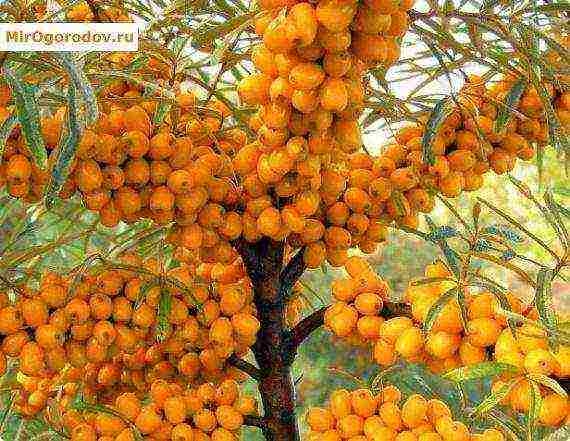
Berry bouquet - fruiting shoots of the Chuiskaya cultivar
The most winter hardy
Sea buckthorn is a Siberian plant, therefore winter hardiness is its usual characteristic. And yet I would like to note a few particularly frost-resistant varieties.
- Sea buckthorn golden cob is medium late in terms of ripening, among the advantages in the description of the variety are high winter hardiness, good yield, early onset of fruiting (for 3 years), weak branching. Berries are medium-sized (0.4–0.5 g), golden-orange, collected in dense cobs.
- Sea buckthorn Trofimovskaya belongs to highly winter-hardy varieties. The fruits are large (up to 0.7 g), elongated, orange with a red tint, rich in ascorbic acid, ripen in early September. The shrub is tall, spreading, forms an umbrella crown, withstands not only Siberian frosts, but also European changes in winter temperatures.
The winter-hardy group also includes Dar Katuni, Vladimirka, Popular, Botanical amateur, Otradnaya.
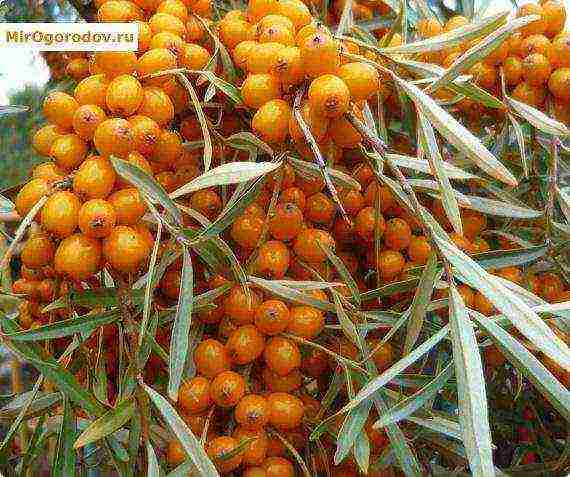
A golden ear is a fair characterization in the literal and figurative sense
The most "courageous"
Whatever sea buckthorn varieties you prefer, you cannot do without a pollinator variety. The choice of "boys" is not as great as the "girls", among the most demanded are the handsome Aley and the Dwarf.
- Aley sea buckthorn is a powerful sprawling shrub of Siberian selection with a luxurious crown, viable flower buds, abundant and long flowering. It has no thorns on the shoots, a single ovary is possible, gives a lot of growth.
- The male cultivar Gnome is characterized by productivity, winter hardiness, and disease resistance. This is a dwarf (no higher than 2.5 m), compact bush with large dark green leaves, concave towards the center of the plate in a boat. Little Dwarf has high quality and very fine pollen, capable of fertilizing more than 10 female plants.

Alei on the eve of spring flowering
Interesting! A new direction in breeding is the development of sea buckthorn varieties that do not need a pollinator. The self-fertile sea buckthorn hybrid is the first result of this search. A tree up to 3 m high is capable of tying large berries weighing up to 2 g without a male plant in the garden.

Sea buckthorn feminization - variety Samoplodnaya
The most original
Fans of exotic curiosities in the garden will like the unusual herringbone variety. The shrub is more decorative than fruit. The bush is low, conical, with a narrowed crown. The resemblance to the herringbone is found in the arrangement of twigs and narrow lanceolate leaves. The berries are small, lemon-green in color, sour in taste.
Zoning varieties
Until now, there is a misconception that since sea buckthorn is a Siberian plant, then in milder European conditions it will take root all the more. This is wrong. In parallel, two areas of selection are developing - Siberian and European. There are, of course, universal forms, but, nevertheless, European shrubs are more adapted to the conditions of winter temperature drops, prolonged thaws, and dry summers. They have better resistance to fungal infections.
Sea buckthorn of European varieties is suitable for the Moscow region and the middle zone. These are Augustine, Moscow beauty, Giant, Botanicheskaya, Vatutinskaya, Nivelena, Ryabinovaya, Perchik.
Siberian cultivars, on the contrary, have a shorter period of deep dormancy, they can withstand severe frosts, but they can freeze after a thaw, they do not like heat. The best varieties of sea buckthorn for Siberia are Radiant, Panteleevskaya, Excellent, Chuiskaya, Abundant, Giant, Lyubimaya.
The Ural climate is ideal for growing this berry shrub and is able to provide yields of 15–20 kg per tree, but this is subject to the planting of zoned material.Sea buckthorn, bred specifically for this region, is distinguished by its large-fruited, yield and winter hardiness varieties and is fully adapted for the Urals. These are Chuiskaya, Chanterelle, Ryzhik, Solnyshko, Koster, Amber necklace.
Moscow, Russia, on the site since 11.01.2017
Have you read it? Don't forget to rate
(
estimates, average:
out of 5)
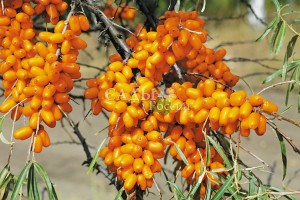
Sea buckthorn varieties Ekaterina
More than 60 varieties of sea buckthorn are included in the State Register, and dozens more are successfully undergoing variety trials. For planting, it is best to use sea buckthorn varieties of local origin, as the most suitable. In Siberia, the popular varieties are Katun, Oranzhevaya, Chuiskaya, Dar Samorodok, Velikan and others. In central Russia, the best varieties are: Alei, Botanicheskaya, Lyubimaya, Krasnoplodnaya and many others.
Favorite by many gardeners, sea buckthorn is a dioecious plant, pollinated with pollen carried by the wind. Therefore, in the gardens, it is necessary to plant male and female specimens of sea buckthorn at a distance of no more than 10 meters from each other. This is sufficient for reliable pollination. One male sea buckthorn is capable of qualitatively pollinating several female plants, but for reliability, at least two "boys" should be planted in case one of the pollinators dies. If space in the garden is limited, then both male sea buckthorns can be planted side by side, at a distance of half a meter from each other.
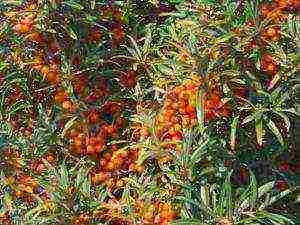
Sea buckthorn variety Augustinka
AUGUSTINKA An early ripe variety of sea buckthorn. The bush is medium-sized, has a medium spreading umbrella-shaped crown. Suitable for the European part of Russia. The fruits are oval in shape, have a light orange color with a red base, pleasant aroma and sour taste. Ripen in mid-August. Productivity is more than 16 kg from a 6-7 year old bush.
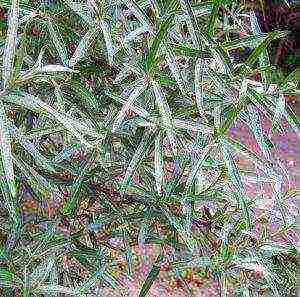
Sea buckthorn - Alei variety
ALEY. Male sterile pollinator. Barren. The plant is vigorous with a strong crown. Shoots without thorns, large buds and shortened internodes are characteristic. High winter hardiness, flower buds easily tolerate frost. Long flowering with a lot of viable pollen. The variety is easily propagated by cuttings. Loves sunny places, grows well on fertile sandy loam and loamy soils provided with moisture. It is resistant to pests and diseases.
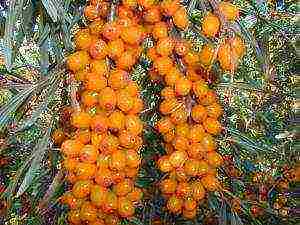
Sea buckthorn botanical
ALTAI... Included in the State Register for the West Siberian region. Late summer ripening. Universal purpose. Medium-sized plant with a compact, dense crown. There are few thorns on the shoots. Fruits weighing 0.7 g, oval, bright orange, juicy, sweet, excellent taste. The separation is easy.
BOTANICAL. Medium-sized tree with a rounded pyramidal shape. The branches are medium spreading, with straight shoots and short spines in the upper part. Leaves are lanceolate, medium in size. The inflorescence contains 6-8 flowers. The fruits are large, light orange, oval-rounded, the skin is thin, the pulp is juicy, with a pleasant aroma, and sour. Productivity 6-7 kg. The separation of the berry is dry and light, the stalk is long. The fruits can be eaten fresh. The pulp contains 80 mg% ascorbic acid, 1.9% sugars. Used to obtain sea buckthorn oil.
BOTANICAL AMATEUR... Zoned variety for central Russia. Shrub up to four meters high with a pyramidal crown. There are few thorns, the leaves are light green, large. The berries are large, yellow-orange in color, oval-cylindrical with scales. They ripen early (in the first half of August). The fruits overripe very quickly and become non-transportable. Pulp with a pleasant pineapple aroma. This variety of sea buckthorn begins to bear fruit in the fourth year after planting. The yield is about 15 kilograms. The shrub is resistant to tracheomycotic desiccation and to various pests. Technical purpose.
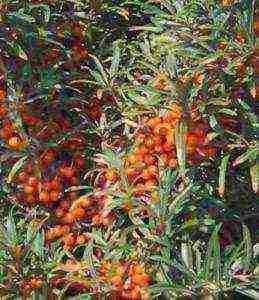
Sea buckthorn botanical amateur
BOTANICAL FRAGRANCE.
The variety is winter-hardy, photophilous, hygrophilous.The bush is medium-sized, with a rounded spreading crown. Leaves are green, slightly pubescent, with a silvery bloom. Well formed, loves rejuvenating shoot pruning. The number of shoots is 0 - 2 points. In the bud there are 6 - 8 flowers, of which 4 - 8 fruits are formed. Fruits are round-oblong, orange-red, shiny, with a red spot at the top. The peel of the fruit is dense, the pulp is juicy, the taste is slightly acidic with aroma. Fruit separation is dry and light. Ripening period is average (10.VIII - 1.IX). High-yielding variety: from a 9-year-old bush - more than 25 kg. Fruits with a high content of vitamin C (up to 184.8 mg%), carotenoids (up to 5.6 mg%). Transportable. The purpose is technical.
Sea Buckthorn Giant
GIANT... A tree or medium-sized bush 2.5-3.5 m high with an oval crown of medium density. The main branch is well marked, there are no thorns on the shoots. Loves the sun and light sandy soils. Begins to bear fruit annually and abundantly in the fourth year after planting. Cylindrical, large, orange fruits ripen in mid-September. A variety of sea buckthorn for universal use. The fruits are suitable for fresh consumption and for various types of processing. Winter hardiness is high.
ELIZABETH. Classic variety of domestic selection. A bush of moderate growth, with a compact crown. Abundant fruiting. The fruits are large, orange, cylindrical. The pulp is juicy, with a sweet and sour taste and a pleasant aroma. This sea buckthorn variety has a high content of vitamins and biologically active substances. Late ripening variety. Winter hardy, resistant to pests and diseases.

Sea buckthorn variety Herringbone
Christmas tree Quite a scarce variety of sea buckthorn. A bush with a conical, narrow crown. The arrangement of twigs with leaves is very reminiscent of a young Christmas tree. The berries ripen by the end of September. Fruits are lemon-green, small, sour. The variety is resistant to diseases and frost.
GOLDEN SIBERIA... Bred at the Research Institute of Horticulture in Siberia. Zoned in the Altai Territory. A tree or shrub of medium vigor. Height about 2.5 m, crown of medium density, oval with a diameter of about 2 m. Shoots are gray-green, with a thorn 2-3 mm at the end. The leaves are lanceolate, dark green, small. Productivity 11-16 kg. Fruits are large, orange, oval, slightly acidic, for universal use. Ripening occurs in early September.
RED-FRUIT... The homeland of the red-fruited sea buckthorn, or shepherdia, is North America. Slightly spreading, medium-sized bush. In terms of sugar content and vitamin content, shepherdia fruits are several times better than ordinary sea buckthorn. The thorniness is insignificant. The variety is winter-hardy. The plant is fast-growing and high-yielding. At the time of fruiting begins in the 3-4th year. Fruits are red, shiny, irregular in shape, rounded slightly widened towards the peduncle. The pulp of the berries is sour, juicy, the skin is dense.

Sea buckthorn varieties Moskvichka
DARLING... The variety is approved for use in the Central, Ural and West Siberian regions of Russia. A bush of medium vigor with a flat-rounded crown. Shoots are straight, with small thorns and whitish pubescence. Leaves are light green, silvery underneath. The fruits are orange, oval in shape with a dense skin. Medium density pulp, good taste. Ripening occurs at the end of August. Productivity is high, annual fruiting. The fruits of this sea buckthorn variety are suitable for various types of processing, freezing and fresh consumption. Winter hardiness is high. It is resistant to pests and diseases.
Moskvichka... The sea buckthorn variety zoned for central Russia. Medium-sized, up to 2.5 m high bush with a compact pyramidal crown. The fruits are large (0.72 g), dark orange with red spots, oval. The pulp is juicy, aromatic, sweet and sour dessert taste. This variety is fruitful, transportable, winter-hardy. Resistant to pests and diseases.
MOSCOW PINEAPPLE. The bush is tall (up to 3 m), medium spreading.Straight shoots with few thorns. The leaves are green, there is a silvery bloom on the underside. Fruits are orange with a red "tan", pear-shaped with a thin skin, fragrant. The pulp is juicy, it tastes sweet and sour. The fruits of this sea buckthorn variety ripen in the second half of August. The skin is thin, tender, the pulp is juicy, with aroma. The yield is good. The variety is resistant to pests and diseases.
Sea buckthorn Moscow Beauty
MOSCOW BEAUTY... Medium-sized, compact tree with few thorns. Fruits are slightly larger than average, oblong-rounded, yellow-orange with a red spot at the base. Ripening period - the second decade of August. The pulp is tender, sour taste with a weak aroma. The skin is thick, dense, dry separation, good transportability. This variety for dessert purposes is resistant to pests, diseases and winter frosts.
NIVELENA... Included in the State Register for the Northwest Region. The bush is medium-sized, slightly spreading, the crown is umbrella-shaped. Shoots are straight, low thorny, light brown, dull. The leaves are small, narrow-lanceolate, green. Multi-flowered inflorescence consisting of small nondescript flowers. The berries are large, yellow-orange, round. The pulp is sweet and sour, aromatic. Fruits ripen in the second half of August. Well transported. The variety is resistant to frost, is not damaged by pests, and is not affected by diseases.
FRIEND Included in the State Register for the West Siberian region. Differs in an average ripening period and versatility of purpose. The plant is slightly spreading and medium-sized. Shoots are straight, thin and without thorns. The leaves are medium in size, their color is light green. The leaf has a medium pubescent shiny plate. Fruit weight is 0.8 g, average, round-oval orange, skin of medium thickness, refreshing sweet and sour taste.
CHUISKAYA... A rare, spreading crown of a tree with moderate growth and high frost resistance. There are few thorns on the shoots. Fruiting begins a maximum of 5 years after planting. The yield is about 9-10 kilograms. Oval-cylindrical, large orange berries. Ripening occurs in August in the second half. The fruit tastes sweet and sour, suitable for canning, processing and fresh consumption.
ESSEL A variety with large fruits, berries have a very sweet taste. The bush is thornless, making the berries easy to pick. The variety is quite fruitful and is in great demand in the Altai Territory.
The best varieties of sea buckthorn:
• by winter hardiness: Gift of Katun, Golden Cob, Multivitamin, Popular, Vladimirka, Favorite Michaly;
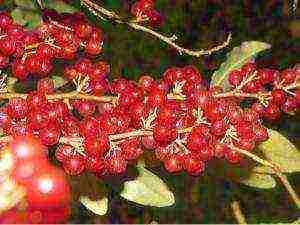
Red Sea Buckthorn
• by yield: Botanical aromatic, Botanical amateur, Perchik's hybrid, Moscow beauty, Nivelena, Finnish;
by the amount of carotenoids (vitamin for vision): Hybrid Perchik, Krasnokarminovaya, Krasnoplodnaya, Moskvichka, Moscow beauty, Rowan;
by the content of vitamin C: Augustinka, Vorobievskaya, Kaliningrad, Otradnaya, Perchik, Trofimovskaya;
by the share of sea buckthorn oil: Gomel, Moscow transparent, Smart, Russian woman, University
by taste: Vorobievskaya, Perchik Hybrid, Augustinka, Fragrant, Botanical, Moskvichka, Moscow pineapple.
The best varieties of sea buckthorn for the Moscow region and the European part of Russia: Augustinka, Botanicheskaya, Nivelena, Ryabinovaya, Vorobievskaya.
sea buckthorn variety for the Urals: Giant, Excellent, Trofimovskaya, Chuiskaya, Amber.
sea buckthorn varieties without thorns and thorns: Botanical, Essel
the sweetest varieties of sea buckthorn: Favorite, Moscow pineapple, Moscow beauty
Comparative characteristics of sea buckthorn varieties
| Variety | Fruit quality, score | Fruit weight, g | Yield, kg / bush | Regenerative capacity,% | |
| Taste | Appearance | ||||
| Augustine | 4,1 | 4,4 | 0,60 | 7,8 | 61,3 |
| Botanical aromatic | 4,1 | 4,3 | 0,33 | 5,6 | 56,3 |
| Botanical amateur | 4,3 | 4,3 | 0,47 | 9,5 | 59,6 |
| Giant | 4,9 | 4,7 | 0,70 | 6,8 | 28,6 |
| Krasnoplodnaya | 3,9 | 3,7 | 0,35 | 7,2 | 61,0 |
| Lomonosovskaya | 4,3 | 4,2 | 0,46 | 9,2 | 56,6 |
| Altai news | 4,3 | 3,7 | 0,35 | 4,5 | 81,8 |
| Omskaya 27 | 4,2 | 4,1 | 0,38 | 5,2 | 80,0 |
| Excellent | 4,4 | 4,1 | 0,45 | 4,5 | 61,5 |
| Nugget | 4,7 | 4,5 | 0,50 | 6,1 | 59,6 |
| Trofimovskaya | 4,8 | 4,8 | 0,58 | 7,4 | 64,0 |
| Amber berry | 3,9 | 4,4 | 0,70 | 7,4 | 61,3 |
